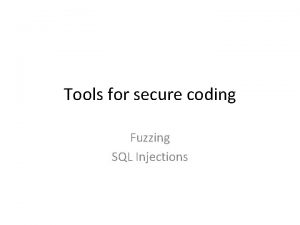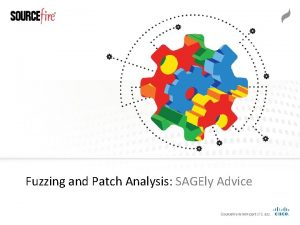Introduction to Info Sec Fuzzing Nir Krakowski nirkrako














- Slides: 14

Introduction to Info. Sec – Fuzzing Nir Krakowski (nirkrako at post. tau. ac. il) Itamar Gilad (infosec 15 at modprobe. net)

Today • Introduction to fuzzing • Fuzzing principles • Useful tools and leads

What is fuzzing? ● ● Fuzzing == Looking for vulnerabilities not by reverse engineering the binary / source code, but rather – by playing with the data ובעברית == התססה The basic idea is to throw lots and lots of ‘weird’ input at the target, and see if things break Assuming the target is poorly written, bad data will crash it (Even if it won’t crash, we can usually find a way to know if something bad happened)

Fuzzing principles • Fuzzing takes time • We want to automate everything • Basic elements in our ‘endless’ loop – o Target startup (process / network service / VM) o Feeding the target our test vector o Monitoring the target’s health (black box / white box) o Logging successful iterations – ‘bad’ test vector (and the way it was generated if relevant)

Generating test vectors • Naive solution: iterate over the entire input range • But that is impractical for almost all scenarios • Our objective is to find a way to cover the most lines of code in the least amount of CPU time • Two main approaches – o Generation – generate input from scratch, following the most minimal set of rules required o Mutation – Using a valid starting point (sample), start flipping / moving / inserting bits

Preparing to fuzz a format • Read the protocol / file format documentation • Observe several test-cases with ghex / wireshark • Find important fields – o Length fields o Checksums o Flags o Tree-like structures o Etc. • We may need to make sure some or all of these are ‘correct’ • Or, we may want them to be incorrect!

Basic example - Browser • We’ll try to fuzz MS Internet Explorer 6. 0 • Elements – o Target startup + Feeding the target our test vector by running “iexplore %s” %target_file o Monitoring the target’s health – by testing if the process is still alive after ‘x’ seconds o Any sample that crashed IE will be saved o Before moving to the next iteration – kill left-over IE to always start with similar conditions

Another example – Network Daemon • Almost any network server will do • Elements – o Feeding the target our test vector via a TCP connection o Monitoring the target’s health – by issuing benign requests constantly o If the server has died – log Everything o Collect core dump via ssh / remote agent o Restart via ssh / remote agent

Faster? Stronger? • • Until now, we stuck with the most external level of control We want to have more information about the crash And we want to be able to try more test vectors But we don’t have more CPU time…

Faster! Stronger! • Solution: restart from the middle – o Install a breakpoint o ‘Freeze’ the memory and state when the breakpoint is triggered o Apply test vector o Run until function / module / process exit / crash o Restart • Can be done o With a ‘smart’ debugger o With an entire VM (Leveraging snapshots) o With better instrumentation (white-box testing)

The sad truth • The truth is that finding crashes is not that hard • Finding exploitable vulnerabilities is a lot harder • Good fuzzing usually requires a lot of tuning and afterprocessing to filter out the noise • After you get a crash, there are some Triage steps that can help you figure out “how exploitable” the bug is – o Form your data with simple patterns o Inspect registers, stack & heap after crash o See if any of your patterns remain o (slightly) modify the patterns and repeat

Further reading & Tools • Google ‘fuzzing’ / ‘fuzzer’ / ‘python fuzzer’ / ‘protocol fuzzer’ • Fuzzing. org is a great resource • As are many good papers / slideshows you’ll find via google(especially lectures from Black. Hat)

This week’s exercise • Fuzzing the Image. Magick image-processing suite • Fuzzing Image file formats • Mutation based fuzzing (“bit flipping”) • Bonus – Smarter fuzzing

Questions?



























